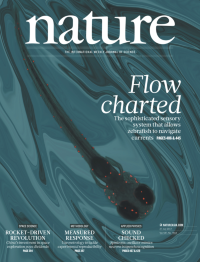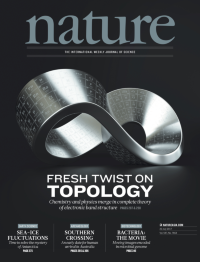Volume 547
-
No. 7664 27 July 2017
The cover shows the larva of a zebrafish (Danio rerio). In this issue, Florian Engert and his colleagues offer insight into the sensory system that allows fish to detect the flow of the water in which they swim. In a behaviour known as rheotaxis, fish consistently manage to orient and swim against oncoming currents, even when they lack any visual cues. The authors investigated this ability in larval zebrafish, and found that the secret is a series of hair cells â shown in red â known as the lateral line. They propose that these hair cells are used to estimate flow direction by detecting the rotation of local flow fields around the fish body. In the wild, this would enable the fish to navigate in environments that lack visual cues. Cover illustration: Julia Kuhl; zebrafish image: Robert Kasper & Pablo Oteiza
-
No. 7663 20 July 2017
The past few decades have revealed the surprising fact that the rules of mathematical topology can determine the properties of materials. But which structures have topological features and which ones donât? Predicting whether a material might be topologically interesting is a challenging task and physicists have so far found only a few hundred âEopological� compounds. In this issue, an international collaboration of physicists, mathematicians and chemists offers a potential solution in the form of a new and complete theory for calculating the topological properties of the electronic band structures of materials. They bring together the thus-far disconnected points of view of physicists and chemists by combining the conventional band-structure approach � which considers electron properties in nonlocal, momentum space � with local chemical bonding. As a result, they complete the theory of electronic band structure, which can now classify the band structures for all of the 230 possible crystal symmetry groups that arise from local atomic orbitals situated on lattice sites. Using this they are able to determine which structures are topologically nontrivial, and they apply the theory to discover several new classes of materials. The theory should greatly simplify the search for further materials with exotic properties and also shed light on the underlying physics of existing topological materials. Cover illustration by JVG.
-
No. 7662 13 July 2017
The cover image shows a paired helical filament of tau protein, which is the major component of tangles in Alzheimerâs disease. Tau filaments make up the protein inclusions seen inside nerve cells in the brains of people with many neurodegenerative conditions, including Alzheimerâs. In this issue, Sjors Scheres, Michel Goedert and their colleagues reveal the first high-resolution structures of the two forms of tau filaments in Alzheimerâs disease. The filaments were isolated from the brain of an individual with Alzheimerâs and imaged using cryo-electron microscopy. In both forms, the individual tau proteins form C shapes (white and blue), which stack together to form filaments. The high-resolution structures of these filaments may help the development of novel diagnostics and therapeutic compounds. Cover image: Thomas G. Martin
-
No. 7661 6 July 2017
In this weekâs special issue, Nature zeroes in on that most basic element of life: the cell. Technological advances are powering analyses previously impossible at the single-cell level. As a result, researchers are at last starting to chart how many different types of cell exist in complex organisms, what they do and how they change during development. Efforts to trace cell lineage are examined in a News Feature (page 20), along with a profile of Aviv Regev (page 24), who is spearheading an effort to catalogue every kind of cell in the human body. Elsewhere, researchers explore how the genome is packaged in a mouse cell throughout the division cycle (page 61) and what this might mean for examining genome interactions in 3D (page 34). And Amir Giladi and Ido Amit discuss how a focus on immune cells might aid our ability to combat diseases such as cancer (page 27). A Careers interview explores the reasons for making the move into single-cell analysis (page 129), and Toolbox takes a look at how best to probe the data being generated as the field expands (page 125). Cover illustration by Jasiek Krzysztofiak/Nature; Images: Morphart Creation/Shutterstock, Jezper/Shutterstock




